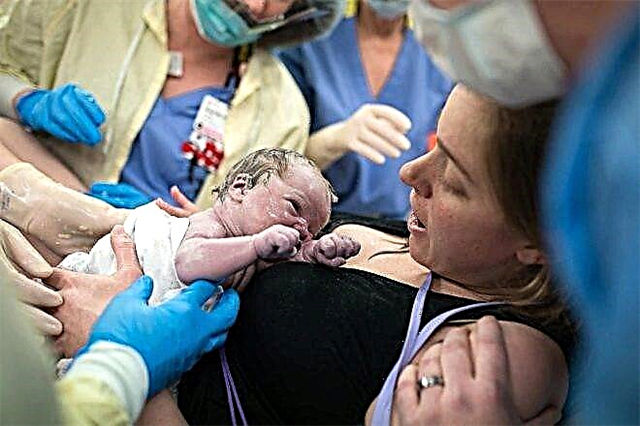
Even women who are very responsible and follow all the doctor's recommendations are not immune from giving birth ahead of time, because the reasons can be very different. In this article, you will find out why labor begins at 34 weeks of gestation, as well as how it proceeds and what is dangerous for the mother and fetus.

Doctors' opinions on the timing
33–34 weeks of gestation is almost eight calendar months of pregnancy. Before the due date, which was determined as the estimated one, there are still about 6 weeks, almost a month and a half. And it is clear that the woman is not thinking about the opportunity to go to the maternity hospital right now. But circumstances may develop in such a way that childbirth will begin spontaneously, or doctors will have an urgent need to terminate the pregnancy, since it can pose a mortal danger to a woman or her child.
Regardless of the reasons why a woman ends up in the hospital at 34 weeks, delivery will be considered premature. In order for childbirth to be considered urgent, it is necessary to bring the child to at least 37 full weeks. But despite the fact that it is still advisable for the baby to spend several weeks in the mother's womb, childbirth at the current date will not be as dangerous as, for example, two weeks earlier.
Today, the training of resuscitators and the level of equipment for resuscitation allows nursing even babies with deep degrees of prematurity in serious condition and with extremely low weight (from 500 grams, and sometimes even lower). At 34 weeks, the baby has enough weight to survive, but there are some nuances, since premature babies are a special category.

Child development and vitality
At 34 weeks, the baby is rapidly gaining weight, and this is a very important process. The presence of sufficient body weight, a sufficient amount of subcutaneous fat will help the baby after birth to maintain internal body heat and prevent severe and dangerous systemic hypothermia, and therefore the doctors will try to do everything to prolong the pregnancy, even for several days, if the woman enters the hospital in a state threatening or starting premature birth. If childbirth already belongs to the category that has begun, then it will no longer be possible to stop or slow it down.
This week, most children weigh on average over 2 kilograms; there are also heroes who already weigh more than 2.5 kilograms. But there are also small children, whose weight may not reach one and a half kilograms. Often, unfavorable factors that provoke the onset of labor before the due date also affect the fetus, and therefore premature babies do not always have average height and weight indicators.
If the child appears at this time, he will be able to please his mother with moderately rounded shapes, the presence of small cheeks and even a moderately chubby booty. By this week, a certain amount of subcutaneous tissue had already been deposited, and due to this, the child stopped looking hypotrophic.

There is almost no doubt that a crumb will be born in a cheese-like lubricant, it is she who covers the baby's body until the skin ripens. By this time, the lubrication is just beginning to gradually decrease. Also, the baby can be born with the remnants of light and very thin hair on the body - the lanugos have not completely left the baby's skin either.
In the child's brain, the process of cortex differentiation is almost complete, but the key word is "almost." The birth of a child at this time will somewhat slow down and disrupt these subtle processes, which can be expressed in neurological ailments of a wide variety of types.
The child has formed all the reflexes necessary for survival in a different environment. But due to insufficient maturity of the brain at birth at this time, the weakness of the manifestation of reflex "skills" is not excluded.

If a boy is born, it is highly likely that his testicles have already descended into the scrotum. Internal organs are growing, their formation was completed in the first trimester. A child born at this time can eat, drink, write, his liver and heart, as well as other organs, work non-stop. But the main, from the point of view of neonatologists, the process takes place in the lungs.
Lung tissue at 33–34 weeks accumulates surfactant - a substance that is produced by small bubbles - alveoli. The more surfactant accumulates by the time the child is born, the higher the likelihood that at the moment of the first independent inhalation the baby's lungs will open, not stick together, will be able to carry out their main functions of gas exchange, the child will be able to breathe himself.
If you arrive at the maternity hospital on time, the doctors can still have time to prepare the baby's lungs for birth. If, according to ultrasound, maturity is insufficient, the woman will be injected with drugs with an artificial surfactant. The same will be introduced to the child after he is born.

Babies who cannot sit in their mother's womb and who have decided to be born exactly at 33–34 weeks are considered quite viable. In most cases, they are awarded the second degree of prematurity according to the international classification. This means that the forecasts for the future are not as good as in children from the first group, but not as alarming as in children of groups 3 and 4 in terms of prematurity.
Home birth and refusal of medical care during this period can kill the child. He cannot do without specialized medical care. In a modern maternity hospital or perinatal center, 97% of children born at 33–34 weeks survive. In most cases, after providing early neonatal care, they grow up quite strong and healthy. 5% of children born at this time still have abnormalities, mainly of a neurological nature. 1% of children born between 33 and 34 weeks get a disability due to total and irreversible damage. The stillbirth rate at this time is about 0.6%.
A baby born at 34 weeks will most likely need the help of resuscitators and neonatologists. He can spend several days in a special heated bed, as he needs additional heating. An artificial respirator can be connected if necessary, oxygen supply and tube feeding are organized.

Causes and features of labor
Labor at 33–34 weeks may start spontaneously. In this case, a woman can either feel the appearance of regular uterine contractions, the frequency and strength of which will increase, or she will immediately face the discharge of water. According to statistics, amniotic fluid at the very beginning of labor leaves in 10% of women with full-term pregnancy. In the case of prematurity, the connection is more alarming: 40% of preterm births begin with the outpouring of water.
In any case, you can't hesitate. The sooner a woman calls an ambulance and goes to the hospital, the better: it is possible that doctors will still have the opportunity to prolong the pregnancy.


As for the reasons why labor begins ahead of time, it is usually:
- infectious and non-infectious diseases of the uterus, ovaries, cervix;
- multiple pregnancy (carrying twins, triplets);
- disruption of the endocrine system;
- chronic diseases of the internal organs of the mother;
- developmental anomalies of the baby, including chromosomal;
- viral infectious diseases transferred during pregnancy;
- smoking, drinking alcohol or drugs;
- unfavorable ecological situation;
- stress;
- fall, blunt trauma to the abdomen.
Consequences and forecasts
For women, childbirth at 34 weeks is almost the same as with a full-term pregnancy. The risks of complications in the process of giving birth are almost the same, but still some of them are increased. In particular, in those who give birth prematurely, ruptures of the cervix and perineum more often occur due to physiological immaturity and unavailability of the genital tract for childbirth. Risks of birth weakness or rapid labor are increased.
For babies, the consequences can be more significant. With low body weight, it is possible that thermoregulation will be impaired. If there is a lack of surfactant, problems with spontaneous breathing may occur. Both of these problems can be eliminated with timely medical assistance. Often in premature babies, due to the immaturity of the brain structures, hemorrhage occurs in certain parts of the organ, which can have very sad consequences, commensurate with the degree of damage to the central nervous system: from minor neurological abnormalities to the development of cerebral palsy, paresis, cerebral disorders, mental and intellectual deviations.

In general, it is rather difficult to predict anything. Each premature baby is different and has its own risk factors and aggravating circumstances. But in general, children during this period adapt well to new conditions, and therefore there is every chance that the child will be alive and healthy.
Reviews
Women who gave birth at 34 weeks of gestation write on thematic forums on the Internet that everything ended well. In the maternity hospital, of course, I had to stay longer, and then the neurologist was followed up with the children for at least a year - these are the rules. But in general, children born at such a time gain weight well, quickly take on the breast and by six months completely catch up in weight and height, as well as in the developmental norms of their peers.
Rumors, widespread among the people, that eight-month-olds survive worse are not confirmed by medicine.

For preterm birth at 34-36 weeks, see the next video.



